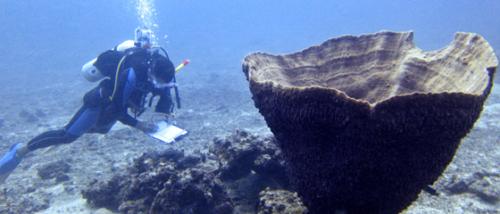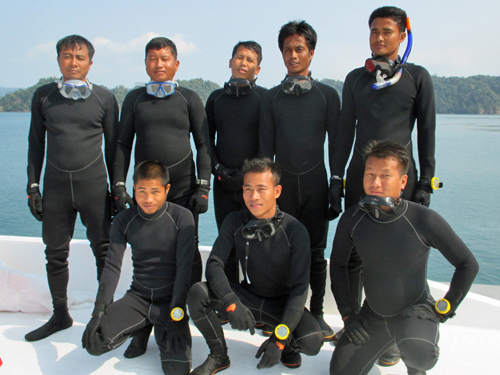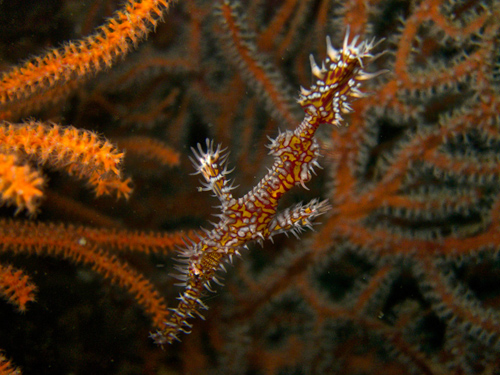Myanmar research reveals underwater treasures by Sarah Rakowski
Scientists returning from a marine research expedition have recorded an astonishing variety of sea life in Myanmar’s Myeik Archipelago.
In just 11 days, the team recorded over 700 coral, invertebrate and fish species, including a number of unidentified specimens that may prove new to science.
These survey results build on concentrated survey effort by a Fauna & Flora International (FFI) team of newly-trained Burmese divers who have been based in the Myeik Archipelago for more than nine months. Data from these surveys have highlighted coral reef areas with staggering hard coral cover.

Scientists returning from a marine research expedition
“Previous surveys of the southern end of the archipelago, which had shown extensive damage from fishing activity, were extremely concerning since Myeik Archipelago is thought to play an important role in replenishing coral reefs throughout the region,” said Sophie Benbow, Asia-Pacific marine programme manager at FFI, who joined this latest expedition.
“With Myeik proposed as a potential World Heritage Site, we wanted to get a clearer picture of what the situation was on the outer reefs, where human impacts were likely to be less severe. What we found was a seascape bursting with life.”
The telltale signs of blast fishing were less evident on the outer reefs, and while wider-ranging fish species were sighted infrequently, overall coral coverage was much greater than the reefs to the south. Even among the inshore reefs, which face higher fishing pressure, coral cover was consistently higher than in the south.
Unusual findings

The Burmese dive team. Credit: Sophie Benbow/FFI.
Corals are fascinating animals, related to jellyfish, which have a symbiotic (mutually-beneficial) relationship with algae called zooxanthellae. These algae live within the coral’s tissue and provide it with oxygen and nutrients through photosynthesis. In return, the coral provides the zooxanthellae with a protected environment and certain compounds it needs to photosynthesise.
“One unexpected observation was the abundance of corals surviving in very murky water around the inshore islands,” said Zau Lunn, FFI’s marine coordinator in Myanmar. This is unusual for corals which generally rely on clear waters that allow sunlight to penetrate so that the zooxanthellae can photosynthesise.
“This finding excited the team and these reefs were among the most species-rich we visited on the expedition,” he added.
Among many other gems, the team spotted barramundi cod, ornate ghost pipefish and some species of coral known from both Africa and eastern Asia that had never been observed in Myanmar’s waters before.
Diving into the detail
The Myeik Archipelago is located in Myanmar’s far south and consists of over 800 islands. It is part of the Bay of Bengal Large Marine Ecosystem, upon which over 400 million people depend for food, livelihoods and security.
Unfortunately however, rapid population growth and unsustainable development in the region has led to overexploitation of fish stocks and marine ecosystem degradation. Research such as this therefore has a critical role to play in understanding the ecology of the area and how best to protect it.

The well-camouflaged ornate ghost pipefish. Credit: Lawrence Davis/FFI.
The team (which consisted of both local researchers and internationally-renowned coral reef scientists from the Smithsonian Institute, CORDIO East Africa, IUCN, the Myanmar Forest Department, the Myanmar Environmental Conservation Department, Mawlamyine University and FFI) spent the entire trip aboard a research vessel, and conducted 35 dive surveys across an area stretching more than 300 km from north to south and covering 10,500 km2.
Preliminary results from the expedition (which was funded by Arcadia, the Lighthouse Foundation and the EU) show some reefs had up to 80% hard coral coverage – classing them as ‘excellent’ on standardised global scales – with interesting reef systems built on granite bedrock.
Working with fishing communities
Traditional fishers in the archipelago are nomadic people, depending entirely on marine resources. As our work in the area progresses, we will work closely with local fishers to ensure our conservation strategies are sustainable in the long term, and do not disadvantage these people.
Three sites with excellent coral coverage have been identified in close proximity to local fishing communities – these areas will be the focus of FFI’s ongoing work with local stakeholders, which looks towards expanding the marine protected area coverage in Myanmar to ensure the conservation and sustainable use of the country’s vital marine resources.
Credit to author: Sarah Rakowski, Reference Link: http://phys.org/news/2014-05-myanmar-reveals-underwater-treasures.html


